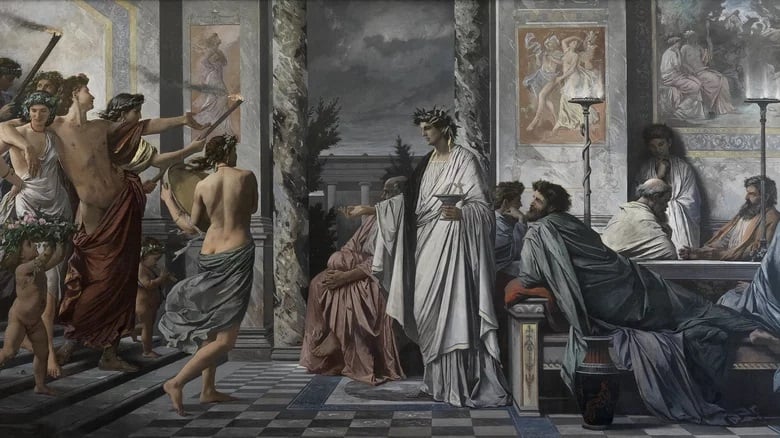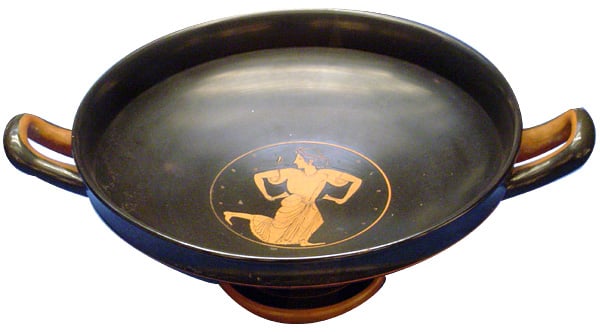
The bars and tavernas of ancient Greece, known as kapeleia, were the mainstay of popular life in ancient cities.
The Ancient Greek elite preferred to drink at private parties known as symposia. The Greek symposium was a key Hellenic social institution. It was a forum for men of respected families to debate, plot, boast, or simply revel with others.
They were frequently held to celebrate the introduction of young men into aristocratic society. Symposia were also held by aristocrats to celebrate other special occasions, such as victories in athletic and poetic contests.
But the working classes had the kapeleion (singular for kapeleia) as the primary vehicle for social interaction.
Bars and tavernas of Ancient Greece “well hidden”
The kapeleia were featured prominently in classical plays. In the comedies of Aristophanes, tavernas appear as an already well-worn feature of the urban environment; their staff in particular are the frequent target of jokes.
Yet, no tangible evidence of the drinking dens has ever been found.
“Taverns are indeed so well hidden. We know them to have existed, yet we cannot seemingly find any physical evidence for the buildings themselves,” said Clare Kelly Blazeby, from the University of Leeds.
The kapeleion, or taverna, is an institution shunned by classicists and archaeologists alike, Blazeby said in an article published in Archaeology Data Service. Preferring instead to focus on the consumption of wine within sympotic, ritual and religious contexts, this mainstay of popular life in the ancient Greek city has long been ignored.
However, archaeologists and historians are certain that peasants and laborers would go to bars which were extremely ubiquitous, especially in democratic cities of Ancient Greece.
“It seems that in oligarchic cities they tended to suppress this kind of activity. In Athens, however, there were lots of neighborhood taverns where normal people went to drink. Women and slaves were said to go to drink there, so there was a much more promiscuous atmosphere,” James Davidson professor of ancient history at the University of Warwick wrote.
“Just as the common messes feed and water the entire citizenry in Sparta, so the whole population of Athens can be found of an evening thronging the kapeleia,” Davidson said, comparing two starkly opposed institutions; the plebeian and democratic Athenian taverna (kapeleion) and Sparta’s communal dining halls.
Most taverns were open to everyone
Unlike the private drinking parties hosted by the wealthy, most taverns were open to almost anyone, including women and slaves. And since the local joints were also under much less pressure to look respectable, it was not uncommon for some places to get pretty wild at times, with a promiscuous atmosphere, according to Warwick Knowledge Center.
Blazeby says that tavernas sold wine “as only barbarians drank beer and vinegar (wine’s natural by-product), and in some establishments, you could have something to eat as well: tragemata (sweets) or hales (savouries) translated as “bar-snacks”.
The wine was stored in amphorae, their shape betraying the region they came from. Once the amphora was opened, the wine would be decanted into a krater (mixing bowl), cooled using a psykter or wine-cooler which stood inside the krater, served from oinochoai or olpai (jugs) and drunk from a variety of plain or decorated cup shapes such as the kylix, kothon and kantharos.

Ancient wine was much stronger than today (around 16 percent) and was always mixed with water, one part wine to three parts water being the preferred admixture.
Like today, it came in three different types, austeros (dry), glukazon (sweet) and autokratos (medium-sweet or somewhere between the two), and could be red, white or rosé.
Ancient Greek homes doubled as tavernas
If, as Davidson claimed, ancient Athenians thronged the kapeleia of an evening, which indeed the ancient sources would appear to corroborate, then there must be a substantial body of archaeological evidence to betray their existence.
The reality, however, turned out to be completely the opposite, Blazeby conceded.
Suspecting that archaeologists were missing something, Blazeby reviewed artifacts unearthed at several private houses across the Greek mainland, dating from 475 to 323 B.C.
She was struck by the fact that some houses had yielded hundreds of drinking cups — far too many even for well-off families hosting lavish parties.
The most likely explanation, according to Blazeby, is that Greek homes doubled as pubs.
Through research, she also pinpointed two areas in ancient Athens and ancient Corinth where kapeleia would have existed.
Over time, the idea of taverns and bars spread from Greece to Rome and throughout Europe. Considering the modern-day importance of taverns, bars, and pubs to countries like the U.S., Ireland, France, Italy, and the U.K., drinkers owe a lot to the Greek ancient civilization.
See all the latest news from Greece and the world at Greekreporter.com. Contact our newsroom to report an update or send your story, photos and videos. Follow GR on Google News and subscribe here to our daily email!



